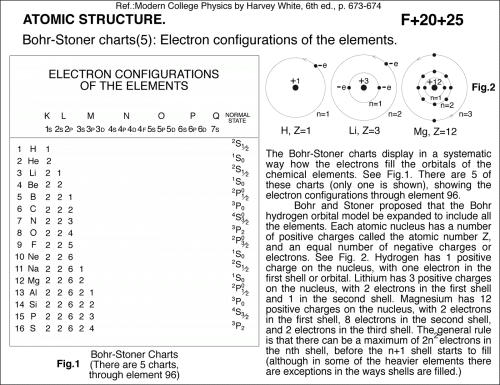Bohr-Stoner charts(5): Electron configurations of the elements.
Primary tabs
Bohr-Stoner charts(5): Electron configurations of the elements. (There are 5 charts, through element 96) Ref.:Modern College Physics by Harvey White, 6th ed., p. 673-674 The Bohr-Stoner charts display in a systematic way how the electrons fill the orbitals of the chemical elements. See Fig.1. There are 5 of these charts (only one is shown), showing the electron configurations through element 96. Bohr and Stoner proposed that the Bohr hydrogen orbital model be expanded to include all the elements. Each atomic nucleus has a number of positive charges called the atomic number Z, and an equal number of negative charges or electrons. See Fig. 2. Hydrogen has 1 positive charge on the nucleus, with one electron in the first shell or orbital. Lithium has 3 positive charges on the nucleus, with 2 electrons in the first shell and 1 in the second shell. Magnesium has 12 positive charges on the nucleus, with 2 electrons in the first shell, 8 electrons in the second shell, and 2 electrons in the third shell. The general rule is that there can be a maximum of 2n electrons in the nth shell, before the n+1 shell starts to fill (although in some of the heavier elements there are exceptions in the ways shells are filled).
UCB Index:
F+20+25
UCB Taxonomy:
Popularity:
- Log in to post comments

